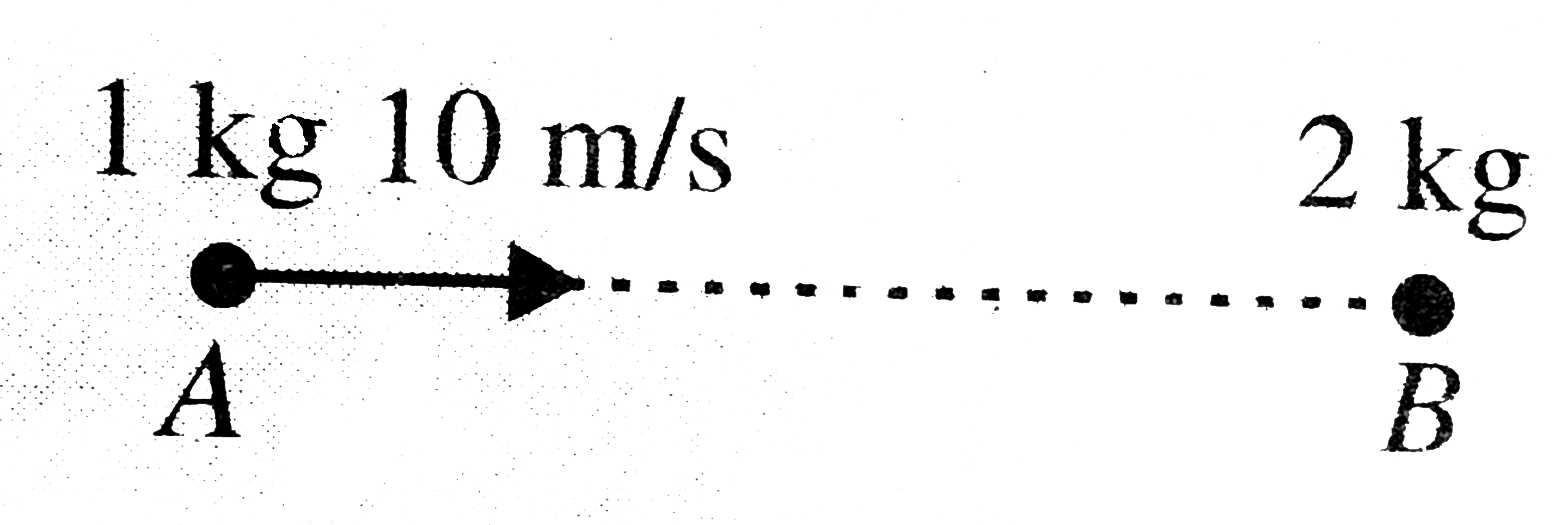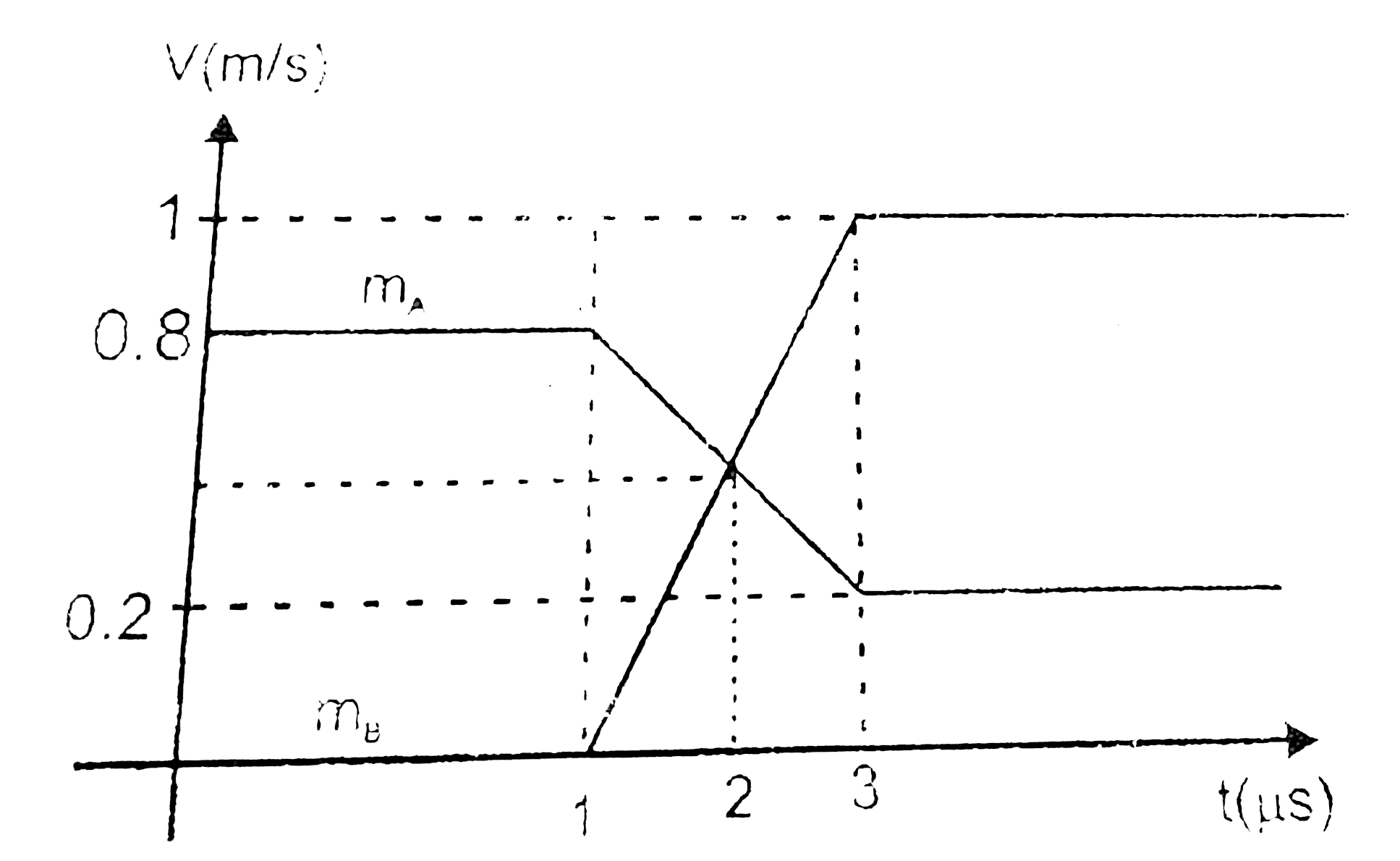Two point prticles A and B are placed in line on frictionless horizontal plane. If particle A (mass 1kg) is move with velocity 10m/s towards stationary particle B (mass 2kg) and after collision the two move at an angle of 45∘ with the initial direction of motion, then find

a. velocites of A and B just after collision.
b. coefficient of restitution
The very first step to solve such problems is to find the line of impact which is along the direction of force applied by A on B, resulting the stationary particle B to move. Thus, by watching the direction of motion of B, line of impact can be determined. in this case, the line of impact is along the direction of motion of B i.e. 45∘ with the initial diretion of motion of A.
a. Let us apply the principle of conservation of momentum.
Along x−direction:
mAuA=mAvAcos45∘mBvBcos45∘
or 1(10)=1(vAcos45∘)+2(vBcos45∘)
or vA+2vB=10√2) ..........i
 Along y direction
Along y direction
0=mAvAsin45∘−mBvBsin45∘
or 0=1(vAsin45∘)−2(vBsin45∘)
or vA=2vB
Solving the two equation vA=10√2m/s and vB=5√2m/s
b. coefficient of restitution
e=velocity of separation along line of impactvelocity of approach along line of impact
=vB−vAcos90∘uAcos45∘=5√2−010√2=12
hence, P is constant.
Topper's Solved these Questions
- BOOK - CENGAGE PHYSICSCHAPTER - CENTRE OF MASSEXERCISE - Solved Examples13videos
CENTRE OF MASS
- BOOK - CENGAGE PHYSICSCHAPTER - CENTRE OF MASSEXERCISE - Exercise 1.120videos
CENTRE OF MASS
- BOOK - CENGAGE PHYSICSCHAPTER - CALORIMETRYEXERCISE - Solved Example13videos
CALORIMETRY
- BOOK - CENGAGE PHYSICSCHAPTER - DIMENSIONS & MEASUREMENTEXERCISE - Integer2videos
DIMENSIONS & MEASUREMENT
Similar Questions
A particle of mass m moving with velocity u collides elastically head on with a particle of mass 2m at rest. After collision the heavier particle moves with velocity?
View SolutionA particle 1 moving with velocity v=10m/s experienced a head on collision with a stationary particle 2 of the same mass. As a result of collision, the kinetic energy of the system decreased by 50%. Find the magnitude and direction of the velocity of the particle 1 after collision.
View Solution
Knowledge Check
- Question 1 - Select One
A ball moving with a speed of 10 m s−1 strikes an identical ball such that after the collision the direction of each ball makes an angle 45∘ with the original line of motion. Find the speeds of the two balls after the collision.
Av1=5√2 m/s,v2=10√2 m/sBv1=10√2 m/s,v2=10√2 m/sCv1=5√2 m/s,v2=5√2 m/sDv1=3√2 m/s,v2=10√2 m/s - Question 2 - Select One
A ball moving with a velocity of 6 m/s strikes an identical stationary ball. After collision each ball moves at angle of 30∘ with the original line of motion. Assuming that the collision is elastic, what are the speeds of the balls after the collision?
A√32m/s,2√3m/sB3m/s,2√3m/sC2√3m/s,2√3m/sD√3ms,√3m/s - Question 3 - Select One
A particle of mass m collides with a stationary particle and continues to move at an angle of 45∘ with respect to the original direction. The second particle also recoils at an angle of 45∘ to this direction. The mass of the second particle is (collision is elastic)
AmB√2mCm√2Dm2
A particle of mass m moving on a smooth surface with velocity 10m/s strikes another particle of mass 2m moving with 5m/s in the same direction . If the collision is elastic and head - on , find velocities of particles after the collision.
View SolutionA particle of mass 2kg moving with a velocity 5ˆim/s collides head-on with another particle of mass 3kg moving with a velocity −2ˆim/s. After the collision the first particle has speed of 1.6m/s in negative x-direction, Find
(a) velocity of the centre of mass after the collision,
(b) velocity of the second particle after the collision.
(c) coefficient of restitution.View SolutionThere are two blocks A and B placed on a smooth surface. Block A has mass 10 kg and its is moving with velocity 0.8 m/s towards stationary B of unknown mass. At the time of collision, their velocities are given by the following graph :

Coefficient of restitution of the collision isView SolutionA ball of mass 1 kg moving with a velocity of 0.4 ms−1 collides with another stationary ball. After the collision, the first ball moves with a velocity of 0.3ms1 in a direction making an angle of 90∘ with its initial direction. The momentum of the second ball after the collision will be (in kg ms−1)
View SolutionA mass ‘m’ moves with a velocity ‘v’ and collides inelastically with another identical mass at rest. After collision the 1st mass moves with velocity v√3 in a direction perpendicular to the initial direction of motion. Find the speed of the 2nd mass after collision :
View Solution

